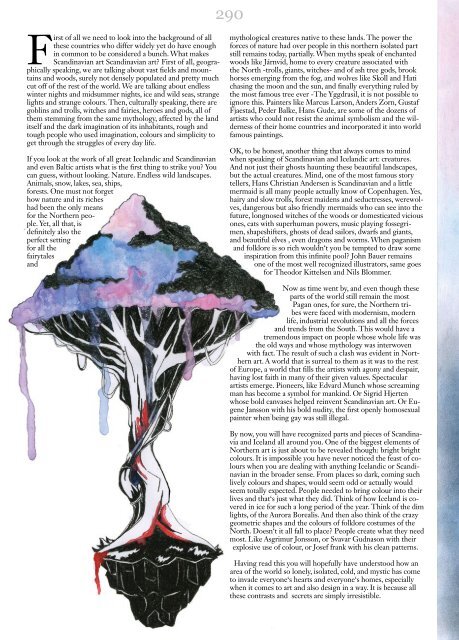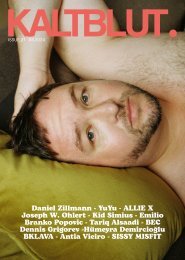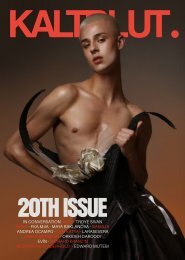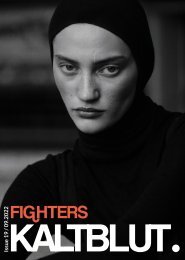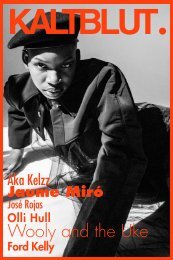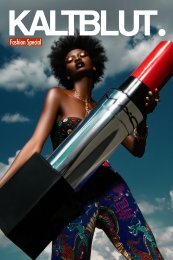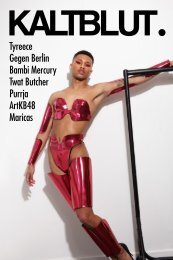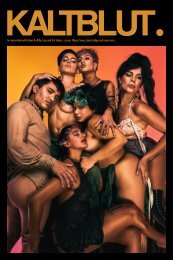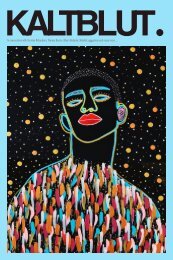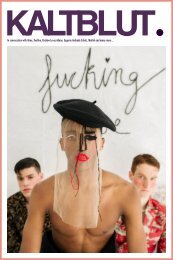Collection 4 THE NORTH
Here we are: COLLECTION 4 THE NORTH Get a print here: http://kaltblutmagazine.bigcartel.com/product/collection-4-the-north Online Issue 404 Pages, included : Jacky Hijstek, Ólöf Arnalds, Mats Udd, The Echo Vamper, Bernhard Musil, Madame Peripetie, Morten Anderson, Nicole Sabouné, Edgar Vila, Lille Santanen, JÖR by Guðmundur Jörundsson, Sóley, Kevin Junk, Polly Balitro, Rough Days For Daimond Trade, Rut Sigurðardóttir, Camilla Storgaard, Anna Gregory, and many more. CLICK HERE TO GET YOUR PRINT COPY: http://kaltblutmagazine.bigcartel.com/product/collection-4-the-north www.kaltblut-magazine.com www.facebook.com/kaltblut.magazine Berlin 2013. All Copyrights at KALTBLUT Media UG and the artists. Enjoy our 4th Collection! Like it? Share it
Here we are: COLLECTION 4 THE NORTH Get a print here: http://kaltblutmagazine.bigcartel.com/product/collection-4-the-north
Online Issue 404 Pages, included : Jacky Hijstek, Ólöf Arnalds, Mats Udd, The Echo Vamper, Bernhard Musil, Madame Peripetie, Morten Anderson, Nicole Sabouné, Edgar Vila, Lille Santanen, JÖR by Guðmundur Jörundsson, Sóley, Kevin Junk, Polly Balitro, Rough Days For Daimond Trade, Rut Sigurðardóttir, Camilla Storgaard, Anna Gregory, and many more. CLICK HERE TO GET YOUR PRINT COPY: http://kaltblutmagazine.bigcartel.com/product/collection-4-the-north
www.kaltblut-magazine.com www.facebook.com/kaltblut.magazine Berlin 2013. All Copyrights at KALTBLUT Media UG and the artists. Enjoy our 4th Collection! Like it? Share it
Create successful ePaper yourself
Turn your PDF publications into a flip-book with our unique Google optimized e-Paper software.
First of all we need to look into the background of all<br />
these countries who differ widely yet do have enough<br />
in common to be considered a bunch. What makes<br />
Scandinavian art Scandinavian art? First of all, geographically<br />
speaking, we are talking about vast fields and mountains<br />
and woods, surely not densely populated and pretty much<br />
cut off of the rest of the world. We are talking about endless<br />
winter nights and midsummer nights, ice and wild seas, strange<br />
lights and strange colours. Then, culturally speaking, there are<br />
goblins and trolls, witches and fairies, heroes and gods, all of<br />
them stemming from the same mythology, affected by the land<br />
itself and the dark imagination of its inhabitants, rough and<br />
tough people who used imagination, colours and simplicity to<br />
get through the struggles of every day life.<br />
If you look at the work of all great Icelandic and Scandinavian<br />
and even Baltic artists what is the first thing to strike you? You<br />
can guess, without looking. Nature. Endless wild landscapes.<br />
Animals, snow, lakes, sea, ships,<br />
forests. One must not forget<br />
how nature and its riches<br />
had been the only means<br />
for the Northern people.<br />
Yet, all that, is<br />
definitely also the<br />
perfect setting<br />
for all the<br />
fairytales<br />
and<br />
290<br />
mythological creatures native to these lands. The power the<br />
forces of nature had over people in this northern isolated part<br />
still remains today, partially. When myths speak of enchanted<br />
woods like Járnvid, home to every creature associated with<br />
the North -trolls, giants, witches- and of ash tree gods, brook<br />
horses emerging from the fog, and wolves like Skoll and Hati<br />
chasing the moon and the sun, and finally everything ruled by<br />
the most famous tree ever -The Yggdrasil, it is not possible to<br />
ignore this. Painters like Marcus Larson, Anders Zorn, gustaf<br />
Fjaestad, Peder Balke, Hans gude, are some of the dozens of<br />
artists who could not resist the animal symbolism and the wilderness<br />
of their home countries and incorporated it into world<br />
famous paintings.<br />
OK, to be honest, another thing that always comes to mind<br />
when speaking of Scandinavian and Icelandic art: creatures.<br />
And not just their ghosts haunting these beautiful landscapes,<br />
but the actual creatures. Mind, one of the most famous story<br />
tellers, Hans Christian Andersen is Scandinavian and a little<br />
mermaid is all many people actually know of Copenhagen. Yes,<br />
hairy and slow trolls, forest maidens and seductresses, werewolves,<br />
dangerous but also friendly mermaids who can see into the<br />
future, longnosed witches of the woods or domesticated vicious<br />
ones, cats with superhuman powers, music playing fossegrimen,<br />
shapeshifters, ghosts of dead sailors, dwarfs and giants,<br />
and beautiful elves , even dragons and worms. When paganism<br />
and folklore is so rich wouldn‘t you be tempted to draw some<br />
inspiration from this infinite pool? John Bauer remains<br />
one of the most well recognized illustrators, same goes<br />
for Theodor Kittelsen and Nils Blommer.<br />
Now as time went by, and even though these<br />
parts of the world still remain the most<br />
Pagan ones, for sure, the Northern tribes<br />
were faced with modernism, modern<br />
life, industrial revolutions and all the forces<br />
and trends from the South. This would have a<br />
tremendous impact on people whose whole life was<br />
the old ways and whose mythology was interwoven<br />
with fact. The result of such a clash was evident in Northern<br />
art. A world that is surreal to them as it was to the rest<br />
of Europe, a world that fills the artists with agony and despair,<br />
having lost faith in many of their given values. Spectacular<br />
artists emerge. Pioneers, like Edvard Munch whose screaming<br />
man has become a symbol for mankind. Or Sigrid Hjerten<br />
whose bold canvases helped reinvent Scandinavian art. Or Eugene<br />
Jansson with his bold nudity, the first openly homosexual<br />
painter when being gay was still illegal.<br />
By now, you will have recognized parts and pieces of Scandinavia<br />
and Iceland all around you. One of the biggest elements of<br />
Northern art is just about to be revealed though: bright bright<br />
colours. It is impossible you have never noticed the feast of colours<br />
when you are dealing with anything Icelandic or Scandinavian<br />
in the broader sense. From places so dark, coming such<br />
lively colours and shapes, would seem odd or actually would<br />
seem totally expected. People needed to bring colour into their<br />
lives and that‘s just what they did. Think of how Iceland is covered<br />
in ice for such a long period of the year. Think of the dim<br />
lights, of the Aurora Borealis. And then also think of the crazy<br />
geometric shapes and the colours of folklore costumes of the<br />
North. Doesn‘t it all fall to place? People create what they need<br />
most. Like Asgrimur Jonsson, or Svavar gudnason with their<br />
explosive use of colour, or Josef frank with his clean patterns.<br />
Having read this you will hopefully have understood how an<br />
area of the world so lonely, isolated, cold, and mystic has come<br />
to invade everyone‘s hearts and everyone‘s homes, especially<br />
when it comes to art and also design in a way. It is because all<br />
these contrasts and secrets are simply irresistible.


